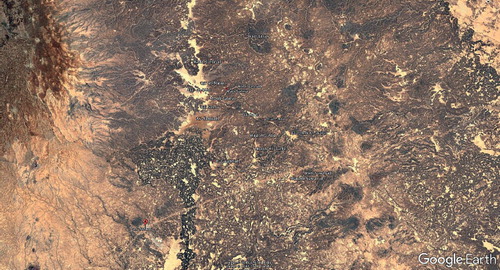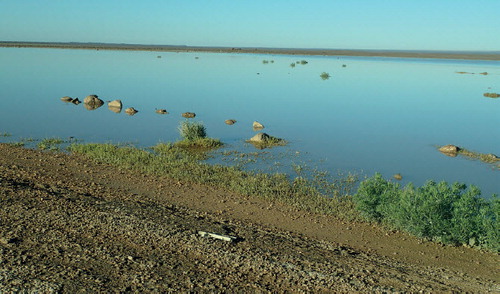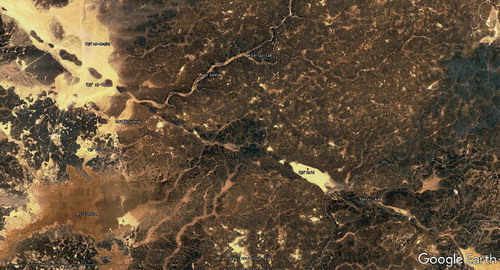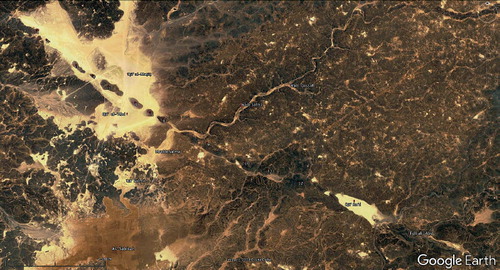The ḥarra, or basalt desert, of north-eastern Jordan is full of vast numbers of ‘Safaitic inscriptions’, graffiti carved by ancient nomads roughly between the 1st century BC and the 4th century AD. There are also thousands of rock drawings of wild and domestic animals, entertainment, battles and hunts, which date from prehistory to the present day. One area that is particularly rich in both the inscriptions and drawings is the region in and around Wādī Salmā, north-north-east of Al-Ṣafāwī. Many of the inscriptions from this area are longer and more informative than those from other regions, and in the past it has attracted a number of epigraphic surveys. Unfortunately, many of these were undertaken before the advent of digital photography and GPS. As such, when the inscriptions have been published, they have often appeared without photographs and with very vague provenance. Indeed, some of the inscriptions recorded in recent years have been published several times, in each case with a different provenance! Given the importance of these texts, this was clearly a situation that needed to be clarified.
The Wādī Salma Area Epigraphic Survey was, therefore, designed to make a systematic epigraphic survey of three areas: (1) Wādī Salmā itself and its tributaries; (2) a number of other specific and well-defined areas within its vicinity; and (3) an area, to the south-east, Wādī al-Ghuṣayn, from which many other important inscriptions had been published but with very few photographs and confused provenances.
The Survey grew out of the Online Corpus of the Inscriptions of Ancient North Arabia (OCIANA), a project funded by the UK’s Arts and Humanities Research Council, and based at the Khalili Research Centre, University of Oxford. In Phase 2, which was completed in March 2017, this created an online database of all known Ancient North Arabian inscriptions (Safaitic, Hismaic, Taymanitic, Dadanitic, Dumaitic, Hasaitic, and in Phase 3 will add Thamudic) and covers the area of Arabia north of Yemen, as well as Jordan and southern Syria. One of OCIANA’s aims is to provide photographs and accurate geographical data for as many of these inscriptions as possible. This survey was, therefore, designed to make the first systematic search of the Wādī Salmā and the Wādī al-Ghuṣayn regions in order to provide as complete and as systematic a record as possible of the inscriptions of the area. This includes both new discoveries and those which have been published as coming from this area, but for which there were little or no photographic or geographical data.
Thanks to generous research grants from The Seven Pillars of Wisdom Trust and the Council for British Research in the Levant, the team was able to spend three weeks making a systematic epigraphic survey of these regions and in the process recorded more than 10,000 inscriptions. We also systematically photographed the physical environment in which the texts were found, something that is very important for the understanding of the texts and has often been neglected in the past.
The survey took place in April 2015 and we were fortunate that in the previous month there had been very heavy rains, so many areas of the desert were covered in pasture and wild flowers, and the mud flats formed large lakes. Not only did this provide a very beautiful research environment, but it made clear the reasons for the distribution of many of the inscriptions which indicate that their authors were pasturing their sheep, goats and camels, and were near sources of water, many of which would not be visible in normal circumstances.
We began at the point at which Wādī Salmā widens out into a fertile plain, known as Mrabb Salmā, which was covered in vegetation at this time. We worked our way systematically up both banks of the wadi, each of which was incredibly rich in inscriptions and rock drawings. Most of these were concentrated at cairns or other structures, though a significant number were on individual stones in the carpet of broken-up lava, which covers the ground. It is worth noting that often the most interesting inscriptions can be single texts in a sea of uninscribed boulders, and these are only found by systematic surveying across the landscape, rather than hopping from one landmark to another. We spent eight days in Wādī Salmā during which time we recorded over 2000 inscriptions. Once we had surveyed as far up the wadi as we were permitted to go (the area is near the border with Syria), we then surveyed its major tributary, Wādī Qaṣṣāb, which joins it from the north-east. At the junction of the two wadis we found an inscription with the first reference to Jerusalem in a Safaitic inscription. Unfortunately, we were only permitted to work for just over a kilometre up this wadi, but we hope to be able to complete the survey of both these wadis in happier times.
One of the major features of this area is a large hill with an almost straight line of 12 small hillocks known as Tell al-ʿAbd wa-ʿayāl-hu (Tell al-ʿAbd and his family). In 1950, the great Canadian epigraphist, Fred V. Winnett, conducted a survey on Tell al-ʿAbd itself. At that time, there was a limited supply of photographic film, which had to be protected from the heat, and so he had to record many of the inscriptions by hand. Furthermore, he was only able to record their positions rather vaguely. With digital photography and GPS we were in the fortunate position of being able to photograph almost all the texts he had found—a handful seem to have disappeared—and record their positions accurately with GPS. As an example of the usefulness of this process, one of the stones we found bore three inscriptions (), two of which (SIJ 746 and 806) had been copied by a member of Winnett’s expedition, but with no indication that they were on the same stone, and a third, which had not been recorded at all.
Fig. 5. SIJ 746, 806 and one text that was not copied by Winnett’s expedition on a stone on Tell al-ʿAbd.
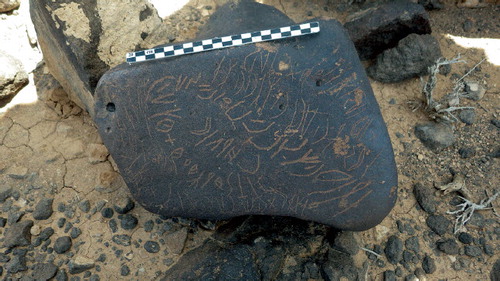
Having completed the survey of Tell al-ʿAbd, we then examined each member of his ‘family’, and on some found many texts, while on others there were none. On one stone we found a single text at the very top detailing that the author had buried his son at this lookout point. To the south of Tell al-ʿAbd, is a plain known as Mrabb al-Šurfāʾ or Šurfāt. The borders of this plain were extremely rich in inscriptions and these have now been edited by Phillip Stokes at the University of Texas at Austin as part of his doctoral thesis, before being entered in the OCIANA database.
Having completed the surveys of areas one and two, we then moved to area three: Wādī al-Ghuṣayn (see ). We started at a point at which the wadi was joined by a tributary, close to the Mafraq–Baghdad road, and systematically worked our way upstream. In this wadi, we found relatively few inscriptions on single rocks in the general basalt scatter, the vast majority being concentrated at outcrops or on the top of promontories. Once again, there was a mixture of texts that had been reported before, and new ones, including a six-line graffito in cursive Palmyrene dated to 259 AD. This is currently under study by Dr Maria Gorea of the CNRS in Paris.
Since we returned from the survey, work has progressed well on entering all the texts into the OCIANA database. The majority of the photographs taken on the survey have now either been matched to previously published inscriptions or have been entered as new finds. OCIANA is already online providing an easily searchable database of some 22,000 published and previously unpublished inscriptions (http://krcfm.orient.ox.ac.uk/fmi/webd_ociana). At the end of the present phase of the project, in March 2017, the online database will contain some 40,000 Safaitic, Hismaic, Taymanitic, Dadanitic, Dumaitic and Hasaitic texts, each with images and all available ancillary data together with geographical information. In Phase 3, which will start after March 2017, the approximately 13,000 Thamudic inscriptions will be entered as well as all newly discovered inscriptions in the other corpora.
Finally, a large number of Arabic inscriptions from the 1st century AD to the present day were also recorded on the survey. Between April 2017 and April 2018, Ali Al-Manaser at the Khalili Research Centre, University of Oxford, entered all these, together with all others known from the area, into a separate but linked database, in a project funded by the Barakat Foundation.
We are most grateful to the Director of Antiquities, HE Dr Monther Jamhawi, for granting the survey a permit, and the Director of the Mafraq Antiquities Office, Dr Abdalqader Al-Husan for his collaboration. The survey was based at the Badia Research Centre at Al-Ṣafāwī and we would like to thank the Centre’s Director, Dr Odeh Masaʿīd and his staff for their hospitality. At the beginning and end of the mission, three of the team members stayed at the British Institute in Amman, and we are extremely grateful to its Director, Dr Carol Palmer, and her staff for their hospitality.
Reference
- Winnett, F. V. (1957) Safaitic Inscriptions from Jordan. Toronto: Toronto University Press.


